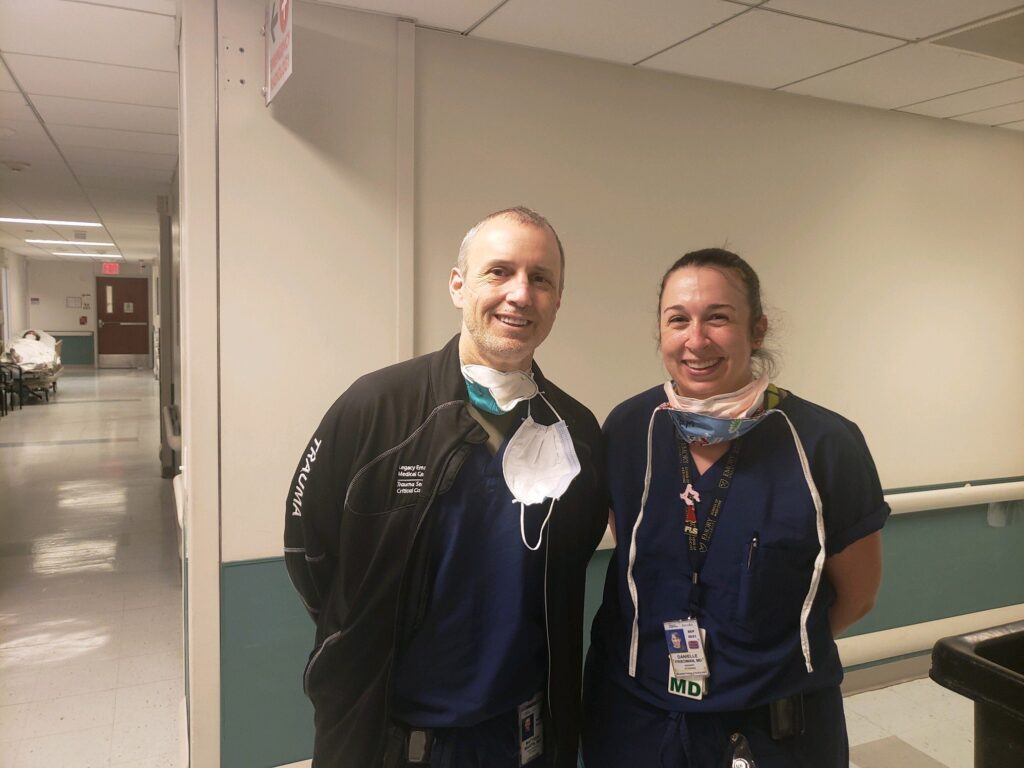ASMBS Profiles in Courage and Caring During COVID-19
Trauma and bariatric surgeon Matthew Martin, MD completed five combat deployments to Iraq and Afghanistan, but not even a war zone could compare to the harsh realities of a frenetic New York City hospital at the height of the COVID-19 pandemic in April.
“It was the worst mass casualty scene I have ever seen. We were seeing overwhelming numbers of patients who were gravely ill, and resources were limited,” said Dr. Martin who recently retired from the U.S. Army, where he served as Chief of Trauma and Chief of Metabolic/Bariatric Surgery at Madigan Army Medical Center in Washington, one of the largest military hospitals on the West Coast.

“It was the worst mass casualty scene I have ever seen.” – Matthew Martin, MD
Dr. Martin, now a surgeon at Scripps Medical Hospital San Diego, doesn’t normally work in New York, but when a fellow trauma surgeon and former colleague at Jacobi Medical Center in the Bronx asked if he could come and help, he was soon on his way for a voluntary two-week “deployment” to the nation’s epicenter of COVID-19 infections. It was a tough decision. Dr. Martin would be leaving behind his wife, an ICU nurse, his 5-year-old twins, and the relative calm of San Diego, where the number of COVID-19 cases was more under control and nowhere near what it was in New York. But both he and his wife agreed, despite the risks, he was needed there and should go.
By mid-April, New York City hospitals and emergency rooms were overrun with COVID-19 cases, and personal protective equipment (PPE) was in short supply. More than 45,000 people were hospitalized and the death toll would reach nearly 17,000 by the end of the month. Meanwhile in San Diego, hospitalizations were significantly lower and the number of reported deaths was 120, a fraction of what they were in New York.
Dr. Martin immediately began working in the ICU on both COVID and non-COVID patients where he met Danielle Friedman, MD, a bariatric surgeon at Jacobi Medical who found herself in the throes of the hospital’s COVID-19 response, as one of two attending surgeons in the ICU.
“As bariatric providers, we take care of patients that tend to have comorbidities and be sicker individuals,” Dr. Friedman said. “We should remember that gives us a skill set that could be used broadly and we should look for ways where we can help out during this pandemic.”
And help out she did. Rather than treating obesity, Dr. Friedman was helping to manage an ICU, treating COVID-19 patients for complications and making critical care decisions about intubation, extubation and ventilator management, among many other things.
“The physical and emotional toll of caring for these patients is quite overwhelming. Patients can be sick and be in the ICU for two, three, four weeks and may look relatively stable for a week or two and then suddenly turn for the worse. I think all of us who were caring for them felt a great reluctance to leave their bedside, to leave the unit and have the possibility of anything changing their status,” Dr. Friedman said.
“The physical and emotional toll of caring for these patients is quite overwhelming.” – Danielle Friedman, MD
Many times, Dr. Friedman found herself the only link between dying patients and their loved ones, holding up an iPhone for isolated COVID-19 patients to say their last goodbyes.
“There’s really just an unbelievable amount of tragedy that we see and the most heartbreaking part about it is the impact on families,” said Dr. Friedman. “We’re seeing patients who are so critically ill and they’re alone. And on the other side of the doorway, you have family members who perhaps last saw their father or mother walking in the hospital with shortness of breath. And then the last time they saw them was perhaps through FaceTime from just outside the door of the ICU so that they can see their face and perhaps hear their voice one last time. And when you’re the one holding the phone next to the patient as he or she passes away, it’s just something that doesn’t leave you.”
But both Dr. Friedman and Dr. Martin, who is back in San Diego, described a perhaps even as powerful opposite feeling — an exhilaration when a patient recovers and is able to leave the hospital. Dr. Friedman put it this way.
“Seeing patients get better is the flip side of the coin that keeps us going. And as a group, we cling to these victories. We are playing songs when patients are liberated from the ventilator, we are cheering. There is nothing more rewarding, not only getting the patient off the ventilator, but seeing the true person of each patient kind of emerge as they start to heal from this very prolonged illness.”